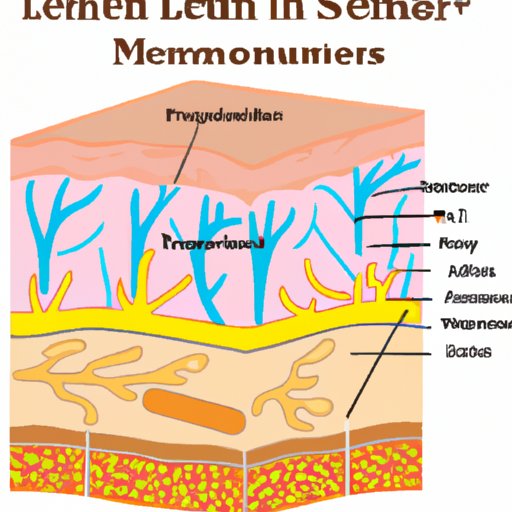Introduction
Skin is a vital organ of the human body and it serves many important functions. It helps to protect our internal organs from external elements, regulates body temperature, and acts as a barrier against infection. Understanding the different layers of the skin is essential in order to comprehend how the skin works and how it can be effectively maintained.

Exploring the Anatomy of the Skin: Understanding the Different Layers
The skin has three main layers: the epidermis, dermis, and subcutaneous layer. Each layer has its own distinct functions and characteristics. Let’s take a look at each layer in more detail.
The Epidermis
The epidermis is the outermost layer of the skin. It is composed of several layers of dead cells that are continually shed and replaced by new cells. The epidermis helps to protect the body from external elements such as bacteria, viruses, and ultraviolet rays. It also helps to regulate body temperature and maintain hydration levels.
The Dermis
The dermis is the middle layer of the skin. It contains collagen and elastin fibers that give the skin its strength and elasticity. The dermis also contains blood vessels, nerve endings, hair follicles, and sweat glands. These structures help to regulate body temperature, provide sensation, and aid in the production of sweat.
The Subcutaneous Layer
The subcutaneous layer is the innermost layer of the skin. It is composed of fat and connective tissue that helps to cushion and insulate the body. This layer also helps to store energy and keep the body warm.
A Comprehensive Guide to the Different Layers of the Skin
Now that we have explored the different layers of the skin, let’s take a closer look at the functions, benefits, and risks associated with each layer.
Functions of Each Layer
The epidermis helps to protect the body from external elements and regulate body temperature. The dermis provides strength and elasticity, regulates body temperature, and provides sensation. The subcutaneous layer cushions and insulates the body, and helps to store energy and keep the body warm.
Benefits and Risks of Each Layer
The epidermis helps to protect the body from external elements, but if it becomes damaged or compromised, it can lead to infections or sunburns. The dermis provides strength and elasticity, but it can be damaged by excessive exposure to the sun or harsh chemicals. The subcutaneous layer cushions and insulates the body, but it can become damaged due to obesity or poor nutrition.
The Science Behind the Skin: What Makes Up Each Layer?
Now that we have explored the various functions and benefits of each layer, let’s take a look at what makes up each layer of the skin.
Anatomical Structure
The epidermis is composed of several layers of flat, dead cells. The dermis is composed of collagen and elastin fibers, blood vessels, nerve endings, hair follicles, and sweat glands. The subcutaneous layer is composed of fat and connective tissue.
Cell Types
The epidermis contains keratinocytes, melanocytes, and Langerhans cells. The dermis contains fibroblasts, macrophages, and mast cells. The subcutaneous layer contains adipocytes and fibroblasts.
Chemical Components
The epidermis contains proteins, lipids, and minerals. The dermis contains collagen, elastin, and glycoproteins. The subcutaneous layer contains fat and connective tissue.

An Overview of Skin Structure: Examining the Different Layers
Now that we have explored the anatomy, structure, and chemical components of the skin, let’s take a look at how the different layers interact with each other.
How the Layers Interact with Each Other
The epidermis and dermis work together to protect the body from external elements and regulate body temperature. The subcutaneous layer cushions and insulates the body, and helps to store energy. All of these layers interact with each other to maintain the health and integrity of the skin.
How the Skin Adapts to Its Environment
The skin adapts to its environment by producing more or less oil, adjusting its thickness, and changing its color. For example, when exposed to cold temperatures, the skin will produce more oil to help retain heat, and when exposed to hot temperatures, the skin will thin out to help dissipate heat.

A Look at the Building Blocks of the Skin: Understanding the Various Layers
Finally, let’s take a look at the building blocks of the skin: proteins, lipids, and minerals.
Proteins
Proteins are the main structural component of the skin. They provide strength and elasticity, and they help to regulate body temperature. Examples of proteins found in the skin include collagen, elastin, and keratin.
Lipids
Lipids are fats that help to protect the skin from external elements. They also help to regulate body temperature and maintain hydration levels. Examples of lipids found in the skin include ceramides, cholesterol, and fatty acids.
Minerals
Minerals are essential for healthy skin. They help to regulate body temperature, maintain hydration levels, and protect the skin from environmental damage. Examples of minerals found in the skin include calcium, magnesium, and zinc.
Conclusion
In conclusion, understanding the different layers of the skin is essential in order to comprehend how the skin works and how it can be effectively maintained. The skin has three main layers: the epidermis, dermis, and subcutaneous layer. Each layer has its own distinct functions and characteristics. The epidermis helps to protect the body from external elements and regulate body temperature. The dermis provides strength and elasticity, and regulates body temperature and provides sensation. The subcutaneous layer cushions and insulates the body, and helps to store energy and keep the body warm. The skin contains proteins, lipids, and minerals that help to regulate body temperature, maintain hydration levels, and protect the skin from environmental damage. By understanding the anatomy, structure, and chemical components of the skin, we can better understand how the different layers interact with each other and how the skin adapts to its environment.


